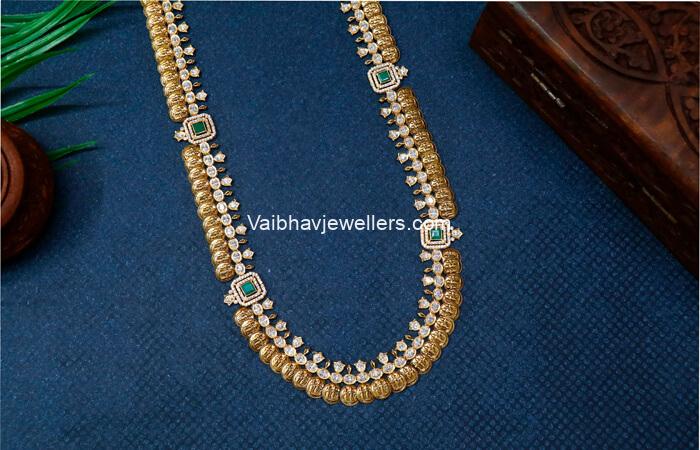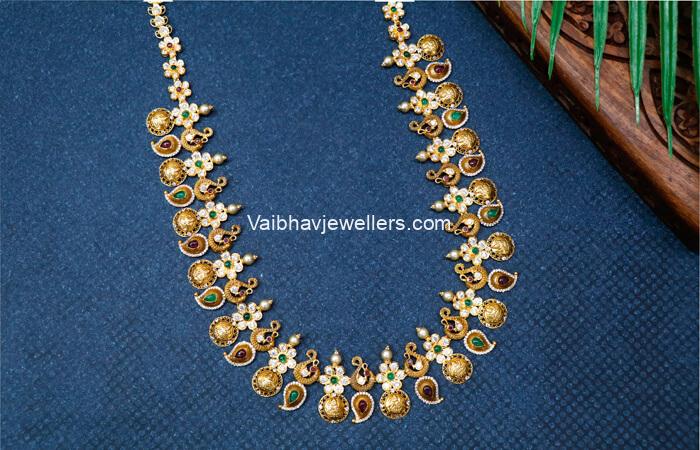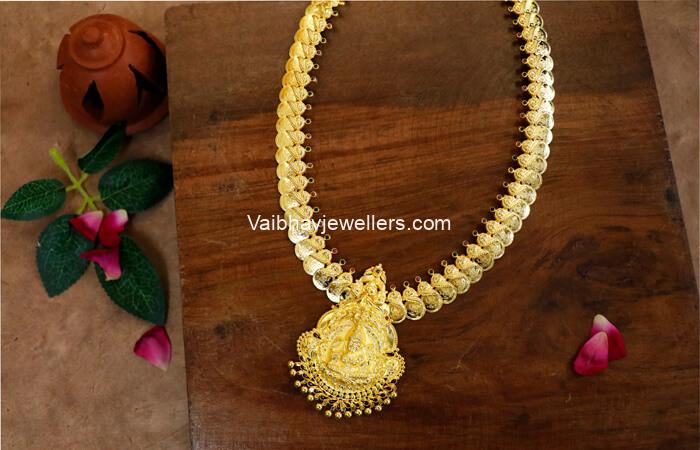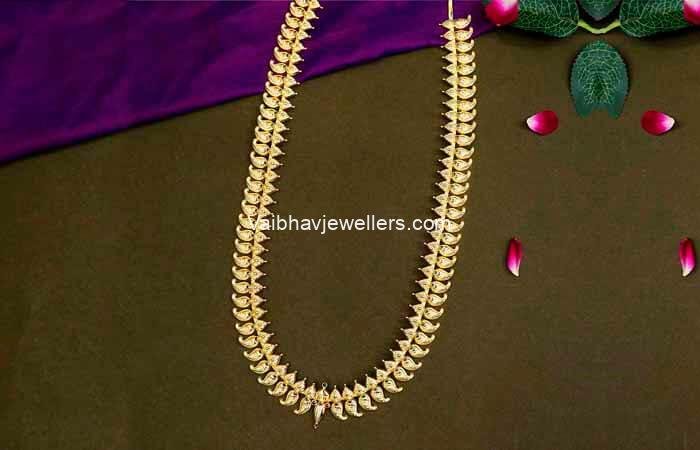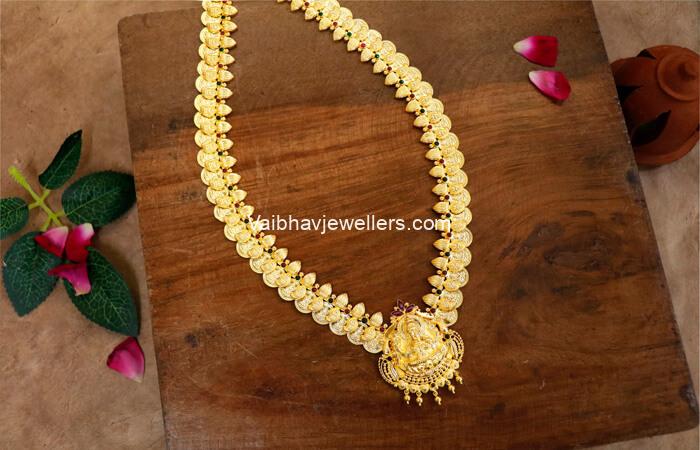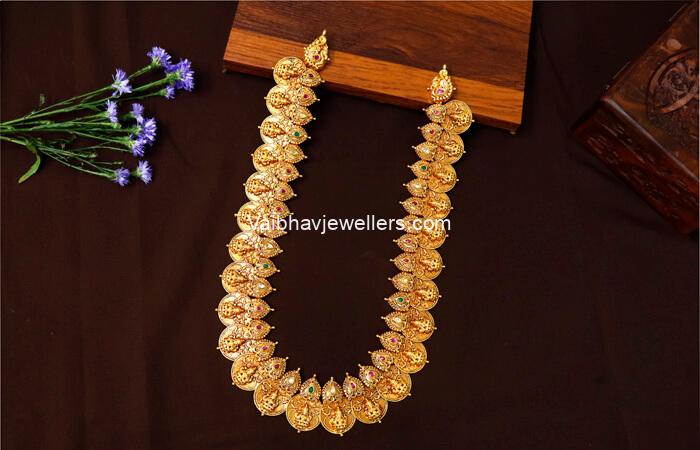
South Indian Kasumala
Vaibhav Jewellers 22K Antique Gold Kundan Haram
Aug 10, 2023
This 22K Antique Gold Kundan Haram from Vaibhav Jewellers is a stunning blend of…
Vaibhav Jewellers 22K Precious Pachi Work CZ Haram-2
Aug 10, 2023
The 22K Precious Pachi Work CZ Haram-2 from Vaibhav Jewellers showcases exceptional craftsmanship with…
Vaibhav Jewellers 22K Precious Pachi Work CZ Haram
Aug 10, 2023
This 22K Precious Pachi Work CZ Haram from Vaibhav Jewellers features exquisite craftsmanship with…
Vaibhav Jewellers 22K Plain Gold Kasulu Haram-3
Aug 10, 2023
The 22K Plain Gold Kasulu Haram-3 from Vaibhav Jewellers is a beautifully crafted piece…
Vaibhav Jewellers 22K Plain Gold Mango Haram
Aug 10, 2023
This 22K Plain Gold Mango Haram from Vaibhav Jewellers showcases intricate mango motifs, adding…
Vaibhav Jewellers 22K Plain Gold Kasulu Haram-2
Aug 10, 2023
The 22K Plain Gold Kasulu Haram-2 from Vaibhav Jewellers features a classic design that…
Elegant Indian Kasumala Designs
India has been blessed with a rich cultural tapestry that spans the entire country with each region boasting its unique styles, cultures, and characteristics. Not just food and art, every region has its different jewelry styles as well. With various fashion and jewelry trends coming and going, one jewelry piece that has stood the test of time and continues to captivate hearts is the South Indian Kasumala. Native to the southern Indian states, kasumalas are immensely popular jewelry pieces that are not just ornaments; they are symbols of tradition, culture, and elegance. In this blog post, we’ll take a deep dive into the world of Indian Kasumala designs, exploring their history, significance, and timeless beauty.
The History Of Kasumala
The word “Kasumala” is derived from two words: “Kasu,” which means coin, and “Mala,” which means necklace. As the name suggests, Kasumalas traditionally consist of gold coins or gold beads that have been flattened into thin disks, intricately strung together to create a breathtaking necklace. The origin of Kasumalas can be traced back to ancient South India, and they have been a part of Indian culture for centuries. Kasumalas have not only been a symbol of wealth and prosperity but also hold significant cultural and religious importance. Made entirely of gold, a precious metal that was considered holy and pure, these gold necklaces were seen on the necks of deities in South Indian temples. In many Indian communities, Kasumalas are given to brides as part of their bridal trousseau, signifying blessings for a prosperous and happy married life.
Kasumalas have a timeless appeal that transcends fashion trends. They are not just jewelry; they are pieces of art that tell a story of tradition, culture, and craftsmanship. Whether you’re a bride on your wedding day, a woman celebrating a special occasion, or simply someone who appreciates the beauty of Indian jewelry, a Kasumala is a statement piece that can be cherished for a lifetime. In a world where fashion often evolves rapidly, the enduring charm of Kasumalas serves as a reminder of the rich cultural heritage that continues to be celebrated through jewelry. So, the next time you wear a Kasumala, take a moment to appreciate not only its exquisite design but also the centuries of history and tradition that it represents.
Design Elements of Kasumala
South Indian Kasumalas have been around for centuries and with time, despite the traditional kasumalas still being just as popular, they have evolved into more contemporary styles and their designs have taken new forms and features. Let’s take a look at the design elements, types and prices of popular kasu mala designs.
- Gold Coins: The trademark feature of a Kasumala is the use of gold coins or gold beads flattened into thin disks resembling coins. These coins vary in size and design, and they are often engraved with intricate floral motifs or animal symbols. The coins are typically arranged in a single or multiple rows, forming the necklace’s centerpiece.
- Temple Motifs: Many Kasumalas feature temple motifs or deities on the gold coins. These motifs add a spiritual and cultural touch to the necklace, making it even more special. It’s common to find depictions of gods and goddesses, as well as intricately carved patterns on the coins.
- Antique Finish: Since kasumalas have a vintage appeal to them, the gold coins in these stunning necklaces are given a rustic and antique finish in order to enhance their look. Jewelers do this to give the necklace a timeless look and feel, making it suitable for both traditional and contemporary occasions.
In addition to the necklace, Kasumala sets often include matching earrings. These earrings complement the design of the necklace, creating a harmonious and balanced look when worn together. Some kasumalas are also embedded with gemstones and beads to further enhance their look and value. The value of a kasu mala also largely depends on its weight which can range anywhere between 16 to 300 grams. For an understated look, you can opt for a kasu mala in 16 grams whereas heavier kasu malas are preferred for festive and wedding occasions.
Regional Differences In Kasu Malas
While kasumalas are native to the southern states of India, their immense beauty and popularity have inspired many other states to adopt and evolve their design while adding their own cultural touch. Nowadays, Kasumalas are not limited to a single design; they exhibit regional variations that reflect the cultural diversity of India.
South Indian Kasumala
South Indian Kasumalas are known for their intricate craftsmanship and elaborate designs. They often feature temple motifs and are made of 22-karat gold. The coins in South Indian Kasumalas have varying sizes and are closely spaced, creating a rich and dense look. These are mostly worn on special festive occasions as well as weddings.
Maharashtrian Kasumala
In Maharashtra, Kasumalas are known as “Thushi” or “Kolhapuri Saaj.” These necklaces are characterized by their distinctive choker-like appearance and intricate beadwork. The gold coins in Maharashtrian Kasumalas are typically larger and fewer in number.
North Indian Kasumalas
North Indian Kasumalas are often simpler in design compared to their southern counterparts. They may feature plain gold coins or coins with minimalistic engravings. These necklaces are typically made of 22-karat gold and are favored for their elegance and versatility.
Occasions To Don a Kasumala
Despite being traditional gold necklaces, kasu malas can certainly be worn for many different occasions. Let’s take a look at how to best style them.
Weddings
Kasumalas are a popular choice for brides, symbolizing prosperity and a bright future. They add a regal touch to the bridal ensemble and are often passed down as family heirlooms.
Festivals
Festivals in India are a time for dressing in traditional attire, and Kasumalas complement these outfits beautifully. Whether it’s Diwali, Dussehra, or any other festival, a Kasumala can elevate your entire look.
Special Occasions
Kasumalas are not limited to weddings and festivals. They can also be worn on special family occasions, such as anniversaries, milestone birthdays, or religious ceremonies.
Tips to Clean and Care for Kasu Mala Necklaces:
To ensure that your Kasumala retains its beauty and luster for generations to come, here are some care tips:
- When not in use, store your Kasumala in a jewelry box or pouch to prevent scratches and tarnishing.
- Gently clean your Kasumala with a soft cloth to remove dirt and oils. Avoid using harsh chemicals or abrasive materials.
- Periodically, have your Kasumala inspected by a professional jeweler to check for loose links, damaged coins, or any other issues that may need repair.
Indian Kasumalas are a testament to the timeless beauty of traditional jewelry. These necklaces, adorned with gold coins and intricate motifs, have been cherished for generations and continue to be a symbol of elegance and culture. Whether you opt for a South Indian, Maharashtrian, or North Indian Kasumala, each design reflects the rich diversity of India’s heritage. As you wear your Kasumala on special occasions or pass it down as a cherished heirloom, remember that it is not just a piece of jewelry; it is a connection to the past and a celebration of the enduring traditions that make India’s jewelry so unique and captivating.

